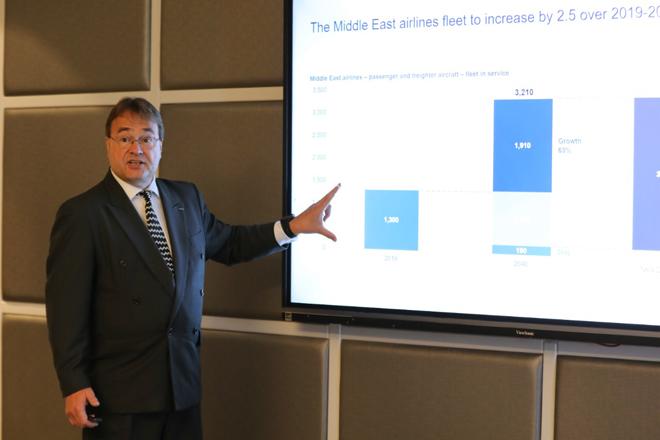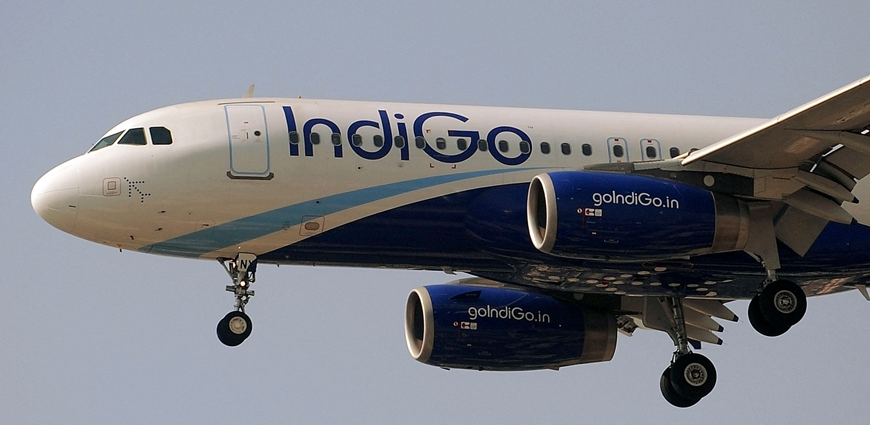You are here
First zero-emission aircraft to take off by 2035 — Airbus
By Rayya Al Muheisen - Jun 09,2022 - Last updated at Jun 09,2022

Joep Ellers, Airbus Airline marketing director for Africa and the Levant, speaks during a media briefing in Amman on Wednesday (Photo by Osama Aqarbeh)
AMMAN — Airbus is working to bring the first zero-emission commercial aircraft to the market by 2035, according to its Marketing Director for Africa and the Levant Joep Ellers.
“Aviation contributes 2.5 per cent to global man-made CO2 emissions,” Ellers said during a media briefing on Wednesday.
Airbus is a global company that provides efficient and technologically advanced solutions in aerospace, defence and commercial aircraft, offering modern and fuel-efficient airliners and associated services. It is also in the space business, according to a presentation during the event.
He added that the world’s first zero-emission commercial aircraft is designed with three concepts, each representing a different approach to achieving zero-emissions flight.
“All of these concepts rely on hydrogen as a primary power source,” he said.
He noted that this technology holds “exceptional promise” as a clean aviation fuel. Additionally, it is likely it will become a solution for aerospace and many other industries to meet their climate-neutral targets, he noted.
He added that the industry has made great progress for sustainable growth, by reducing CO by 50 per cent, CO2 by 80 per cent, NOx by 90 per cent and noise by 75 per cent.
“Airbus aims to rely fully on Sustainable Aviation Fuel (SAF) by 2030,” he added.
SAF is a “drop-in” fuel that can be blended with jet fuel and used in aircraft without requiring any engine modification, according to a slideshow during the presentation.
“SAF is made of sustainable resources such as used cooking oil, municipal solid waste and food waste,” he said.
He added that it reduces CO2 emission up to 80 per cent over its life cycle, compared with jet fuel.
Airbus signed an agreement with the Crown Prince Foundation (CPF) in 2017 to create more opportunities for additional training and education for students from Jordanian universities.
“Airbus received 12 Jordanian students for five-month long internships at Airbus’ central engineering centre in France,” he noted.
He said that this agreement aimed to offer “unique training experiences” to Jordanian engineering students at both the bachelor’s and master’s levels at the Airbus headquarters in Toulouse, France.
“Despite the decrease in business for the aviation sector due to the pandemic, aviation is anticipated to bounce back by 2023,” he added.
Ellers added that 2020 was a tough year for the aviation industry — the growth of the industry was interrupted by the pandemic and its related global travel restrictions, resulting in a 3.5 per cent decrease in the GDP, in addition to a 66 per cent drop in Revenue Passenger Kilometres (RPK).
He continued that passenger numbers fell by 2,700 million and highlighted a load factor of just 65.1 per cent compared to a record 82.5 per cent in 2019.
“Twenty-five years’ worth of global growth of the industry was lost during 2020,” Ellers added.
He noted that the market has been showing increasing signs of recovery, with expectations of a full recovery of global air traffic between 2023 and 2025.
However, “the Middle East offers fundamental enablers for recovery and growth of air travel”, said Ellers.
“The Middle East’s middle class is expected to grow from 230 million people today, to 300 million by 2040,” he stated.
The majority of the population in the region is under 40 years old. Therefore GDP in the Middle East is expected to increase by 1.6 from 2019 to 2040. He added that this class is expected to represent 63 per cent of the population by 2040.
He stated that over 3,000 new aircraft deliveries are required for the Middle East by 2040.
“In the next 20 years, Airbus forecasts that demand for air transport will progressively shift from fleet growth to the accelerated retirement of older, less fuel-efficient aircraft,” he stated.
He added that the shift will result in a need for almost 39,000 newly built passenger and freighter aircraft, 15,250 of which are for replacement purposes.
“There will be a need for over 550,000 new pilots and over 710,000 highly skilled technicians over the next 20 years,” he stated.
He noted that the retirement of older aircraft, as well as the continued improvements in fleet efficiency, sustainable fuels, operations and propulsion technologies will enable the sector’s 2050 net-zero objective.
Related Articles
AMMAN - The Qantas Group and Airbus will invest up to $200 million to accelerate the establishment of a sustainable aviation fuel (SAF) indu
LE BOURGET — European aircraft maker Airbus made a splash on the first day of the Paris Air Show with the announcement of the biggest-ever o
GENEVA — The International Air Transport Association (IATA) called this week for intensified production of Sustainable Aviation Fuel (SAF) t



















